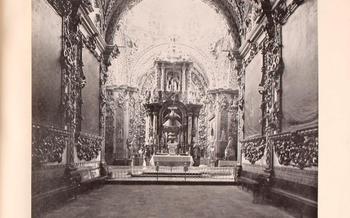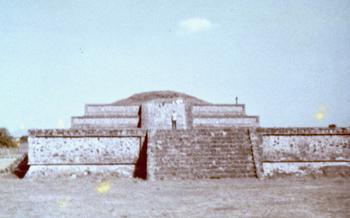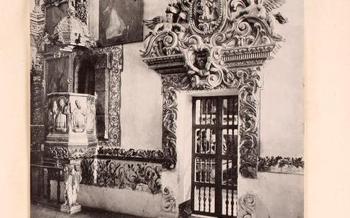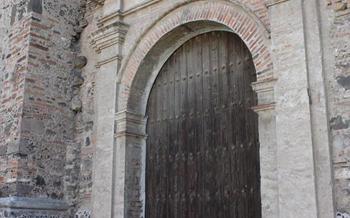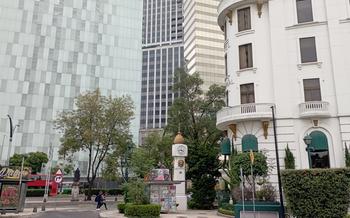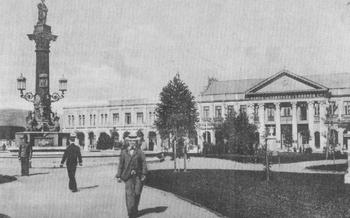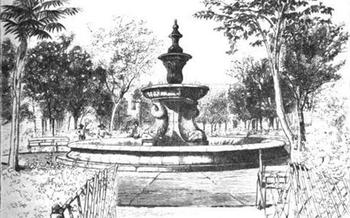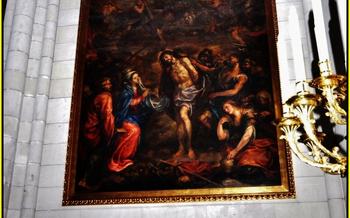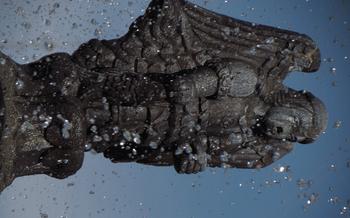
Paseo de los Gigantes
- Paseo de los Gigantes: An Enchanting Artistic Haven
- Exploring the Sculptures: A Visual Symphony
- Sculptor's Haven: A Tribute to Artistic Brilliance
- Interactive Art Experience: Touch, Feel, and Admire
- The Paseo's Allure: A Place of Tranquility and Beauty
- A Walk Through History: Unraveling Puebla's Past
- Local Insights: The Meaning Behind the Sculptures
- Unveiling the Creative Process: From Vision to Reality
- The Paseo's Cultural Significance: A Symbol of Puebla's Identity it is a symbol of Puebla's identity, a testament to its rich history, and a celebration of its vibrant culture. The Paseo is a cultural landmark that represents the essence of Puebla, reflecting its unique blend of European and indigenous influences and showcasing the city's enduring artistic spirit.
- Beyond the Paseo: Exploring Puebla's Art Scene
- Practical Information: Planning Your Visit to the Paseo
- Capturing Memorable Moments: Photography at the Paseo
- Insider Tip: Unveiling Hidden Gems
Paseo de los Gigantes: An Enchanting Artistic Haven
Nestled amidst the vibrant city of Puebla, Mexico, lies a captivating artistic haven known as the Paseo de los Gigantes (Promenade of the Giants). This enchanting walkway showcases a remarkable collection of monumental sculptures, each representing a unique chapter in the city's rich history and cultural heritage.
Artistic Charm: History and Background of the Sculptures
The Paseo de los Gigantes came to life in 1983, when renowned Mexican sculptor, Manuel Tolsá, was commissioned to create a series of statues honoring the city's most prominent figures and historical events. Tolsá's vision was to create a public art space that would celebrate Puebla's unique identity and artistic heritage.
Must-See Sculptures: Notable Works and Their Creators
Among the Paseo's most notable sculptures is the imposing figure of "El Gigante," a towering representation of the city's patron saint, San Miguel Arcángel. Other must-see works include "La Historia de Puebla," a historical narrative depicted in bronze, and "El Sueño de la Malinche," a poetic portrayal of the relationship between the indigenous princess and Spanish conquistador Hernán Cortés.
Cultural Symbolism: Deeper Meanings Behind the Artworks
Beyond their aesthetic beauty, the sculptures of the Paseo de los Gigantes hold profound cultural symbolism. Each piece represents a significant aspect of Puebla's history, identity, and cultural heritage, inviting visitors to delve into the city's rich tapestry of stories and traditions.
Historical Significance: The Role of Paseo in Puebla's Identity
The Paseo de los Gigantes has become an integral part of Puebla's cultural landscape, serving as a living museum that celebrates the city's past, present, and future. This unique artistic space is not only a testament to Puebla's rich artistic heritage but also a symbol of its vibrant cultural identity.
Exploring the Sculptures: A Visual Symphony
The sculptures of the Paseo de los Gigantes showcase a diverse range of artistic styles, materials, and techniques. Some sculptures, such as "The Dancers" by Jorge Marín, are characterized by their graceful and fluid forms, while others, like "The Thinker" by Auguste Rodin, capture the essence of deep contemplation and introspection. The materials used span from traditional bronze and marble to innovative materials such as recycled metal and ceramic.
The Paseo de los Gigantes presents a variety of themes that reflect the rich cultural heritage and history of Puebla. Some sculptures, like "The Eagle and the Serpent" by Juan Soriano, delve into pre-Hispanic mythology, while others, like "The Battle of Puebla" by José Luis Cuevas, depict historical events that shaped the city's identity. The sculptures also explore universal themes such as love, loss, and triumph.
The Paseo de los Gigantes is a testament to the diversity of cultural influences that have shaped Puebla's artistic landscape. European influences are evident in sculptures like "The Triumph of Hercules" by Enrique Carvajal, which draws inspiration from classical mythology. At the same time, pre-Hispanic motifs can be seen in "The Rabbit on the Moon" by Francisco Toledo, which references ancient Mexican legends.
The sculptures of the Paseo de los Gigantes offer a visual narrative of Puebla's history and culture. They capture key moments, events, and symbols that have shaped the city's identity, creating an outdoor museum that celebrates Puebla's rich artistic heritage.
Sculptor's Haven: A Tribute to Artistic Brilliance
The Paseo de los Gigantes is a testament to the exceptional talent and dedication of the sculptors who brought these majestic artworks to life. Among the notable artists who contributed to the Paseo's allure are Jorge Marín, renowned for his captivating bronze sculptures that explore themes of identity and human emotion; Javier Marín, whose works often depict mythical creatures and fantastical beings, inviting viewers to delve into the realm of imagination; and Sebastián, whose sculptures are characterized by their abstract forms and minimalist aesthetic.
These renowned artists, along with many others, were united by a shared passion for artistic excellence and a deep appreciation for the history and culture of Puebla. Collaborating closely, they created a cohesive collection of sculptures that harmoniously blends diverse artistic styles and techniques. The resulting ensemble is a testament to the transformative power of art and the enduring legacy of the sculptors who left an indelible mark on Puebla's cultural landscape.
Interactive Art Experience: Touch, Feel, and Admire
The Paseo de los Gigantes is not just a visual spectacle; it is an interactive experience that invites visitors to engage with the sculptures on a tactile level. The sculptures are not cordoned off or placed behind glass; instead, they are positioned at a height that allows visitors to reach out and touch them. This hands-on interaction encourages a deeper connection with the artworks, allowing visitors to appreciate the textures, materials, and craftsmanship up close.
The tactile experience adds a sensory dimension to the artistic appreciation of the sculptures. The rough surface of a stone sculpture, the smooth finish of a bronze statue, or the intricate details of a ceramic work can be fully appreciated through touch. This multisensory experience enhances the emotional impact of the artworks, creating a lasting memory for visitors.
The interactive nature of the Paseo de los Gigantes also makes it an inclusive space for diverse audiences. Visually impaired visitors, for example, can experience the sculptures through touch, while children can engage with the art in a playful and interactive way. The Paseo's design encourages visitors to explore, discover, and appreciate the sculptures on their own terms, fostering a sense of inclusivity and accessibility.
In addition to encouraging tactile exploration, the Paseo de los Gigantes also invites visitors to develop a deeper understanding of the sculptures through interactive signage. These signs provide information about the artists, the techniques used, and the symbolism behind the artworks, enhancing the visitor's appreciation of the sculptures' artistic and cultural significance.
The Paseo's Allure: A Place of Tranquility and Beauty
The Paseo de los Gigantes is not just an artistic haven; it is also a place of tranquility and beauty. The serene atmosphere created by the lush greenery, vibrant flowers, and gentle breeze invites visitors to relax and immerse themselves in the artistic surroundings. The park's tranquil ambiance provides a respite from the bustling city, allowing visitors to unwind and appreciate the beauty of the sculptures without distractions.
The Paseo is a feast for the eyes, with its vibrant colors, intricate details, and diverse artistic styles. Visitors can stroll through the park, admiring the sculptures from various angles and perspectives. The beauty of the sculptures is not limited to their visual appeal; they also evoke emotions and inspire contemplation. The Paseo offers a unique opportunity to appreciate art in a serene and tranquil environment, making it a perfect place for artistic contemplation and inspiration.
Beyond its artistic significance, the Paseo is also a creative haven for both locals and visitors. It is a place where artists can find inspiration and showcase their talents, and where visitors can develop a deeper understanding and appreciation for sculpture as an art form. The Paseo's tranquil surroundings provide an ideal setting for artistic contemplation, allowing visitors to connect with the sculptures on a deeper level and gain a deeper understanding of their symbolism and significance.
A Walk Through History: Unraveling Puebla's Past
The Paseo de los Gigantes is not just an artistic haven; it's also a living museum that tells the story of Puebla's rich history. The sculptures, arranged chronologically, take visitors on a journey through time, showcasing key events and personalities that shaped the city's identity.
The Paseo begins with sculptures depicting the city's pre-Hispanic roots, highlighting the indigenous cultures that inhabited the region before the arrival of the Spanish. As visitors move along, they encounter sculptures that portray the Spanish conquest, the colonial era, and the Mexican Revolution. Each sculpture tells a unique story, offering glimpses into Puebla's struggles, triumphs, and cultural heritage.
The Paseo also features sculptures that honor notable figures from Puebla's history, such as José María Morelos y Pavón, a hero of the Mexican Independence War, and Benito Juárez, a former president of Mexico. These sculptures serve as a tribute to the individuals who played a crucial role in shaping Puebla's destiny.
Through its sculptures, the Paseo de los Gigantes provides a comprehensive historical narrative of Puebla, inviting visitors to explore the city's past and gain a deeper understanding of its cultural heritage.
Local Insights: The Meaning Behind the Sculptures
The Paseo de los Gigantes is not just a collection of sculptures; it is a living narrative that unfolds through the stories and perspectives of the local community. Each sculpture holds special meaning for the people of Puebla, who have woven legends, folklore, and symbolism into the very fabric of the Paseo.
As you stroll through the park, engage with the locals and ask them about their favorite sculptures. They will share stories of love, loss, triumph, and resilience that have shaped the history of Puebla. Listen to the legends surrounding the sculptures, tales of mythical creatures, hidden treasures, and ancient curses.
Discover the hidden symbolism embedded in the sculptures, symbols that speak of cultural identity, religious beliefs, and the shared experiences of the people of Puebla. The Paseo becomes a bridge between visitors and locals, fostering a cultural exchange that enriches the experience of both.
Unveiling the Creative Process: From Vision to Reality
The Paseo de los Gigantes unveils the creative process, offering a glimpse into the artists' studios and the journey from vision to reality. The artists' inspirations, techniques, and influences are showcased, enabling visitors to understand the creative drivers behind each masterpiece. The Paseo provides a unique opportunity to witness the birth of a sculpture, from the initial concept to its physical manifestation. This behind-the-scenes experience allows visitors to appreciate the skill, dedication, and passion that go into creating these monumental works of art.
**The Paseo's Cultural Significance: A Symbol of Puebla's Identity it is a symbol of Puebla's identity, a testament to its rich history, and a celebration of its vibrant culture. The Paseo is a cultural landmark that represents the essence of Puebla, reflecting its unique blend of European and indigenous influences and showcasing the city's enduring artistic spirit.
The Paseo serves as a source of immense civic pride for the people of Puebla. It is a place where locals and visitors alike can come together to appreciate the beauty of art, learn about the city's history, and connect with the creative energy that permeates the city. The sculptures in the Paseo tell the story of Puebla, depicting significant historical events, cultural traditions, and local legends, providing a tangible link to the city's past and present.
Beyond its local significance, the Paseo de los Gigantes has also played a crucial role in promoting Puebla's cultural vibrancy on a national and international scale. The park has become a must-visit destination for art enthusiasts, attracting visitors from around the world who come to admire the Paseo's unique collection of sculptures. In doing so, the Paseo has helped to raise Puebla's profile as a cultural hub, contributing to the city's growing reputation as a vibrant and dynamic artistic center.
The Paseo de los Gigantes, with its captivating sculptures, rich symbolism, and profound cultural significance, stands as a testament to the enduring spirit of Puebla, showcasing the city's deep-rooted appreciation for the arts and its commitment to preserving its cultural heritage.
Beyond the Paseo: Exploring Puebla's Art Scene
The Paseo the city offers much more to art enthusiasts. Beyond the Paseo, Puebla is home to a vibrant art scene that encompasses galleries, museums, local markets, and street art.
- Art Galleries and Museums:
Puebla boasts a diverse range of art galleries and museums, each offering unique perspectives on the city's artistic heritage. The Museo Amparo is a must-visit, showcasing a vast collection of pre-Hispanic artifacts, colonial-era paintings, and contemporary Mexican art. The Museo José Luis Bello y González is dedicated to the work of the renowned Poblano artist José Luis Bello y González, providing insights into his distinctive style and artistic journey.
- Local Art Markets:
For those seeking authentic souvenirs and handmade crafts, Puebla's local art markets are a treasure trove. The Mercado de Artesanías El Parián is a lively market offering a wide array of traditional Mexican handicrafts, including colorful talavera pottery, intricate silver jewelry, and woven textiles. The Mercado de los Sapos is another popular destination for finding unique and affordable souvenirs.
- Artist Workshops:
To immerse yourself in the creative process and learn from local artisans, consider visiting one of Puebla's many artist workshops. Here, you can engage with skilled craftsmen and women, observe their techniques, and even try your hand at creating your own masterpiece. From pottery workshops to glassblowing studios, there are opportunities for everyone to discover and nurture their artistic side.
- Street Art Scene:
Puebla's vibrant street art scene adds a layer of urban creativity to the city's artistic landscape. Take a stroll through the historic center and discover colorful murals adorning buildings and alleyways. These works of art often depict historical events, local legends, and social issues, providing a glimpse into the city's soul.
Practical Information: Planning Your Visit to the Paseo
Location and Accessibility:
The Paseo de los Gigantes is conveniently located in the heart of Puebla, making it easily accessible for visitors. Situated along Avenida Reforma, the Paseo is within walking distance of many of Puebla's main attractions, including the Zócalo, the Cathedral, and the Amparo Museum. Public transportation options, such as buses and taxis, are readily available for those who prefer not to walk.
Visiting Hours:
The Paseo de los Gigantes is open to the public daily from 9 am to 6 pm. Visitors are free to explore the park and admire the sculptures at their leisure. However, it is worth noting that the lighting conditions are most favorable for photography during the morning and late afternoon hours.
Guided Tours:
For those who wish to delve deeper into the history and symbolism of the Paseo's sculptures, guided tours are available. These tours are led by knowledgeable experts who can provide insights into the creative process, the artists' backgrounds, and the cultural significance of the artworks. Guided tours can be arranged through local tour operators or directly through the Paseo's administration.
Photography Tips:
The Paseo de los Gigantes offers ample opportunities for photography enthusiasts to capture the beauty and artistry of the sculptures. To ensure the best results, it is advisable to visit during the morning or late afternoon when the lighting is most conducive for photography. Experiment with different angles and perspectives to create dynamic and visually appealing compositions. Remember to respect the rights of other visitors and avoid obstructing their views or disturbing the tranquility of the park.
Capturing Memorable Moments: Photography at the Paseo
The Paseo de los Gigantes presents a photographer's paradise, with its stunning sculptures providing endless opportunities for capturing memorable images. To make the most of your photography experience, consider the following tips:
- Ideal Lighting Conditions:
-
The golden hours of sunrise and sunset cast a warm, ethereal glow on the sculptures, enhancing their beauty and creating a magical atmosphere.
-
Angles and Perspective:
- Experiment with different angles and perspectives to create dynamic and visually appealing compositions.
-
Capture the sculptures from below to emphasize their grandeur, or shoot from a distance to showcase their relationship to the surrounding environment.
-
Composition and Focus:
- Pay attention to the composition of your shots, ensuring that the sculptures are well-positioned within the frame and that the background doesn't detract from their impact.
-
Use selective focus to draw attention to specific details or elements of the sculptures.
-
Storytelling Through Photos:
- Infuse your photographs with a narrative by capturing people interacting with the sculptures, or by including elements of the park's surroundings to provide context and create a sense of place.
- Share your photos online or through social media to share the beauty of the Paseo with the world.
Insider Tip: Unveiling Hidden Gems
As you explore the Paseo de los Gigantes, keep an eye out for hidden gems that may not be immediately apparent. Venture off the beaten path to discover lesser-known sculptures tucked away in corners or nestled amidst the lush greenery. These hidden treasures often offer unique perspectives and insights into the Paseo's artistic legacy.
Engage with locals to uncover the secrets of the Paseo. Ask for recommendations on hidden sculptures or lesser-known stories behind the artworks. Locals often have a deep connection to the Paseo and can provide valuable insights that enhance your experience.
Pay attention to the intricate details and symbolism embedded within the sculptures. Look for hidden meanings, references to historical events, or cultural influences that may not be immediately obvious. These hidden elements add depth and richness to the artworks, revealing the complex narratives they convey.
By seeking out hidden gems, engaging with locals, and delving into the symbolism of the sculptures, you'll gain a deeper understanding and appreciation for the Paseo de los Gigantes. Embrace the opportunity to uncover the secrets of this enchanting artistic haven, creating a truly memorable and enriching experience.
